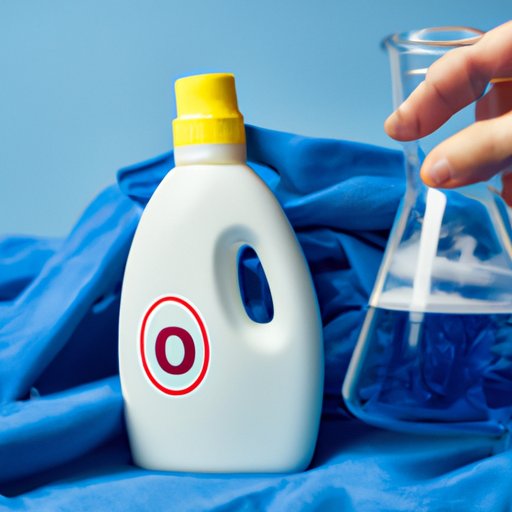Introduction
Fabric softener is a popular household item used to soften clothes and remove static cling. It can be used in both the washing machine and dryer for maximum effectiveness. But what exactly is fabric softener and how does it work? This article will explore the science and chemistry behind fabric softener and how it works to make your clothes softer and fresher.
Exploring the Science Behind Fabric Softener: How Does It Work?
Before understanding how fabric softener works, it’s important to understand what it is and what it does. Fabric softener is a liquid or dryer sheet product that is added to the wash cycle. It works by coating fabric fibers with lubricants that reduce friction and static cling. This makes fabrics feel softer and more comfortable to wear.
The chemistry behind fabric softener is complex. The main ingredients of fabric softener are cationic surfactants, which are molecules containing both hydrophilic (water-loving) and hydrophobic (water-fearing) parts. These molecules are attracted to the negatively charged fibers in fabric and form a protective layer around them. This layer reduces the friction between fibers, resulting in softer fabrics.
In addition to cationic surfactants, fabric softener also contains other chemicals such as solvents, fragrances, and preservatives. These help to enhance the softening effects of the fabric softener and provide a pleasant scent.
The Chemistry of Fabric Softener: What’s in It and How Does It Work?
Fabric softener is made up of several different ingredients. The main active ingredient is cationic surfactants, which are responsible for the softening effect of the fabric softener. Other ingredients may include solvents, fragrances, preservatives, and anti-static agents.
Different types of fabric softeners have different effects on fabrics. Liquid fabric softeners are generally more effective at reducing static cling than dryer sheets, while dryer sheets are more effective at adding a pleasant scent. Some fabric softeners also contain anti-static agents that help prevent static cling from occurring in the first place.

Understanding How Fabric Softener Makes Your Clothes Softer and Fresher
Using fabric softener has many benefits. It helps reduce static cling, making clothes more comfortable to wear. It also adds a pleasant scent to fabrics and helps protect them from wear and tear. Finally, it helps keep fabrics looking newer for longer by protecting them from dirt, dust, and stains.
When using fabric softener, it’s important to follow the manufacturer’s instructions. Generally, fabric softener should be added to the washing machine during the rinse cycle. For best results, use cold water and add one-half cup of fabric softener per load. For extra softness and freshness, use a fabric softener sheet in the dryer.
A Guide to Using Fabric Softener for Maximum Softness and Freshness
For maximum softness and freshness, follow these steps:
- Add one-half cup of fabric softener to the washing machine during the rinse cycle.
- If desired, use a fabric softener sheet in the dryer.
- For extra softness and freshness, add a few drops of essential oil to the fabric softener.
- To reduce static cling, use cold water instead of hot water when washing.
- Replace fabric softener sheets after each use.
Uncovering the Secrets of Fabric Softener: How Does It Actually Work?
So how does fabric softener actually work? The answer lies in the chemistry of fabric softener. When added to the wash cycle, fabric softener coats the fabric fibers with a protective layer of cationic surfactants. These molecules are attracted to the negatively charged fibers in fabric and form a protective layer around them. This layer reduces the friction between fibers, resulting in softer fabrics.
In addition, fabric softener also contains other ingredients such as solvents, fragrances, and preservatives. These help to enhance the softening effects of the fabric softener and provide a pleasant scent. All of these ingredients combine to make fabrics softer and fresher.
Conclusion
Fabric softener is an essential tool for keeping clothes soft and fresh. By understanding the science and chemistry behind fabric softener, you can get the most out of this product and enjoy softer, fresher fabrics. Use the tips outlined in this article to ensure maximum softness and freshness every time you use fabric softener.
From cationic surfactants to solvents, fragrances, and preservatives, fabric softener is composed of several different ingredients that all work together to make fabrics softer and fresher. With the right knowledge and usage tips, you can take full advantage of the power of fabric softener and enjoy the softest, freshest fabrics possible.
(Note: Is this article not meeting your expectations? Do you have knowledge or insights to share? Unlock new opportunities and expand your reach by joining our authors team. Click Registration to join us and share your expertise with our readers.)
